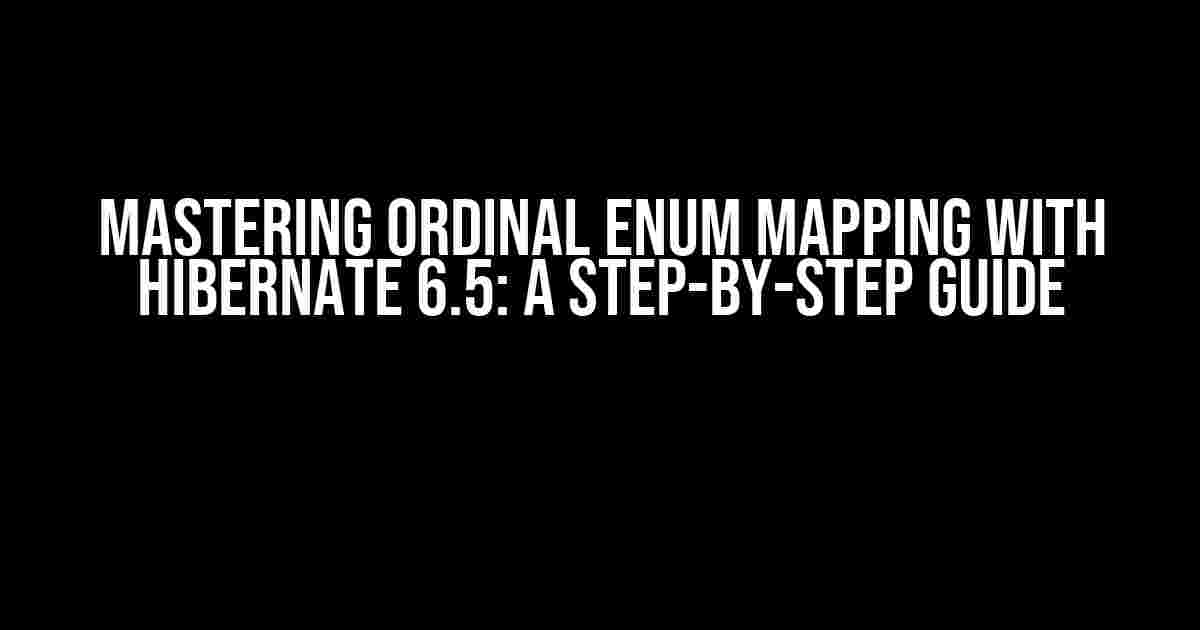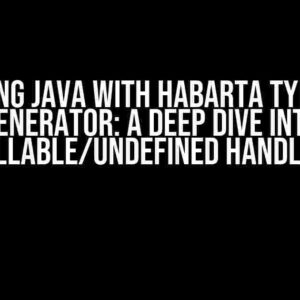Are you tired of dealing with pesky enum mappings in your Hibernate projects? Look no further! In this article, we’ll dive into the world of ordinal enum mapping with Hibernate 6.5, and explore the best practices to make your life easier. So, buckle up and let’s get started!
- What is Ordinal Enum Mapping?
- Configuring Ordinal Enum Mapping with Hibernate 6.5
- Defining the Enum
- Inserting Data
- Querying Data
- Limitations of Ordinal Enum Mapping
- Better Alternative: String-Based Enum Mapping
- Comparison of Ordinal and String-Based Enum Mapping
- Best Practices for Ordinal Enum Mapping
- Conclusion
What is Ordinal Enum Mapping?
In Hibernate, enum mapping is a way to map Java enumerations to a database column. There are two types of enum mappings: ordinal and string-based. In this article, we’ll focus on ordinal enum mapping, which stores the ordinal value of an enum in the database.
Why Use Ordinal Enum Mapping?
Ordinal enum mapping has its advantages. For one, it’s more efficient than string-based mapping since it takes up less storage space. Additionally, it’s faster to query and index. However, it does come with some limitations, which we’ll discuss later.
Configuring Ordinal Enum Mapping with Hibernate 6.5
To get started with ordinal enum mapping, you’ll need to configure Hibernate to use it. Here’s an example:
@Entity
public class MyEntity {
@Enumerated(EnumType.ORDINAL)
private MyEnum myEnum;
// getters and setters
}In the above example, we’ve annotated the `myEnum` field with `@Enumerated(EnumType.ORDINAL)`, which tells Hibernate to use ordinal enum mapping.
Defining the Enum
Now, let’s define the `MyEnum` enum:
public enum MyEnum {
VALUE1,
VALUE2,
VALUE3;
}In this example, we’ve defined an enum with three values: `VALUE1`, `VALUE2`, and `VALUE3`. The ordinal value of each enum will be stored in the database.
Inserting Data
Let’s insert some data into the database:
MyEntity myEntity = new MyEntity();
myEntity.setMyEnum(MyEnum.VALUE2);
session.save(myEntity);In this example, we’ve created a new `MyEntity` object and set its `myEnum` field to `VALUE2`. When we save the object, Hibernate will store the ordinal value of `VALUE2` (which is 1) in the database.
Querying Data
To retrieve the data, we can use a simple Hibernate query:
Query<MyEntity> query = session.createQuery("from MyEntity where myEnum = :myEnum", MyEntity.class);
query.setParameter("myEnum", MyEnum.VALUE2);
List<MyEntity> results = query.getResultList();In this example, we’ve created a query that retrieves all `MyEntity` objects where `myEnum` is `VALUE2`. The ordinal value of `VALUE2` is used in the query.
Limitations of Ordinal Enum Mapping
While ordinal enum mapping has its advantages, it comes with some limitations. One of the main drawbacks is that the ordinal value of an enum can change if the enum is reordered or if a new value is added. This can lead to data inconsistencies and errors.
Another limitation is that ordinal enum mapping is not human-readable. If you need to debug or analyze the data, it can be difficult to understand the meaning of the ordinal values.
Better Alternative: String-Based Enum Mapping
If you’re concerned about the limitations of ordinal enum mapping, you can use string-based enum mapping instead. This approach stores the string value of an enum in the database, which is more human-readable and less prone to errors.
@Entity
public class MyEntity {
@Enumerated(EnumType.STRING)
private MyEnum myEnum;
// getters and setters
}In this example, we’ve annotated the `myEnum` field with `@Enumerated(EnumType.STRING)`, which tells Hibernate to use string-based enum mapping.
Comparison of Ordinal and String-Based Enum Mapping
Let’s compare the two enum mapping approaches:
| Criteria | Ordinal Enum Mapping | String-Based Enum Mapping |
|---|---|---|
| Storage Space | Smaller | Larger |
| Query Performance | Faster | Slower |
| Human-Readability | Low | High |
| Error-Prone | High | Low |
As you can see, each approach has its trade-offs. Ordinal enum mapping is more efficient but less human-readable and more error-prone. String-based enum mapping is more human-readable and less error-prone but takes up more storage space and is slower to query.
Best Practices for Ordinal Enum Mapping
Here are some best practices to keep in mind when using ordinal enum mapping:
- Use ordinal enum mapping only when necessary, such as when storage space is a concern.
- Avoid reordering or adding new values to an enum, as this can lead to data inconsistencies.
- Use a consistent naming convention for your enums to avoid confusion.
- Document your enums clearly, including their ordinal values and meanings.
- Test your code thoroughly to ensure that it handles ordinal enum mapping correctly.
Conclusion
In conclusion, ordinal enum mapping with Hibernate 6.5 is a powerful tool that can be used to efficiently store enum values in a database. However, it comes with its limitations, and you should carefully consider the trade-offs before choosing this approach. By following the best practices outlined in this article, you can ensure that your code is robust, efficient, and easy to maintain.
Remember, enum mapping is just one of the many features that Hibernate has to offer. With Hibernate 6.5, you can take advantage of advanced features like Java 14 records, improved performance, and enhanced support for Java-based configuration.
Stay tuned for more articles on Hibernate 6.5 and Java-based configuration. Happy coding!
Frequently Asked Question
If you’re struggling to map ordinal enums with Hibernate 6.5, you’re not alone! Here are some answers to the most commonly asked questions to get you back on track.
How do I map an ordinal enum in Hibernate 6.5?
To map an ordinal enum in Hibernate 6.5, you need to use the `@Enumerated(EnumType.ORDINAL)` annotation on the enum field in your entity class. For example: `@Enumerated(EnumType.ORDINAL) private MyEnum myEnum;`. This tells Hibernate to store the enum as an ordinal value in the database.
What is the default behavior of Hibernate when mapping enums as ordinals?
By default, Hibernate maps enums as ordinals, using the ordinal value of the enum constant. This means that the first enum constant is stored as 0, the second as 1, and so on. However, you can customize this behavior by using the `@Enumerated` annotation and specifying `EnumType.ORDINAL`.
Can I use ordinal enum mapping with Java enums that have a custom ordinal value?
Yes, you can use ordinal enum mapping with Java enums that have a custom ordinal value. However, you need to ensure that the custom ordinal values are unique and contiguous, starting from 0. If the ordinal values are not contiguous, Hibernate will use the actual ordinal value of the enum constant, which may not be what you expect.
How do I handle null enum values when using ordinal enum mapping?
When using ordinal enum mapping, Hibernate will store null enum values as `null` in the database. However, you can customize this behavior by using the `@Columnnullable` annotation and setting `insertable=false` and `updatable=false`. This will allow you to specify a default value for null enum values.
Can I use ordinal enum mapping with Hibernate 6.5 and Java 14?
Yes, you can use ordinal enum mapping with Hibernate 6.5 and Java 14. However, you need to ensure that you’re using the correct version of Hibernate that supports Java 14. Additionally, you may need to use the `–enable-preview` flag when compiling your Java code to enable support for Java 14 features.


